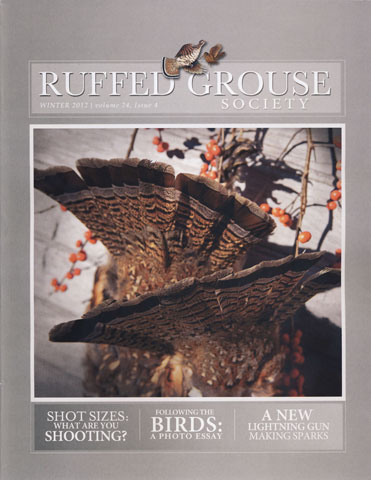Of all the activities I do in the outdoors, be it dog training, shooting, trout fishing, turkey hunting, waterfowling, striper fishing, horseback riding, or anything else, grouse and woodcock hunting ranks first. I count down every day until the season begins like a kid counts down days until summer vacation. I anticipate opening days, and cannot wait to get into the field.
Still, every year around the third week in October I begin to get mixed emotions about pursuing my favorite game birds in my coverts. Around that time I experience a profound change that slows me down. I don’t spring out of bed in the pre-dawn darkness. I walk through the alders and white birch runs more leisurely. Sometimes I take a break and just stop and sit a while.
At about that time my dogs wonder just what the heck is wrong with me. When I pull out a collar with a bell they claw at their kennel doors like caged lions, and to them my lack-luster condition is unbecoming. It’s really a simple thing that is my cross to bear: I’m sad.
I’m sad because I know that the end of the season is near. Think about it. A 45-day woodcock season is about 12% of the year. That means I have another 88% to go until opening day. To me that’s a long time. Don’t get me wrong, I totally enjoy my other sporting activities and the folks I share them with. But compared to grouse and woodcock hunting which occupies my top slot, the rest are sort of a consolation prize. I still enjoy an ice cream sundae even though I really want a piece of double-chocolate cake.
Initially I thought that I would follow the woodcock flights and hunt them along their southern route. For a while I hunted grouse in the winter but then decided they were having a hard enough time finding food in the snowy uplands. Upon closer reflection I felt that I had harassed the birds enough during October and November and that I would leave them alone. Instead, I’d pursue a species native to my home hunting grounds in coastal Massachusetts, the bobwhite quail.
Trading my beloved alder runs and poplar stands is something that is not done very easily. When we get used to bull briars, raspberry thickets, and thick cover with narrow shooting windows we can sometimes get lost in the wide open fields and the softness found in wiregrass, lovegrass, and broom sedge. Pines like loblollys, slash, and longleaf grow tall and majestically.
Most dyed-in-the-wool grouse and woodcock hunters need a few flights to adjust to the open space. At least I do. A snap shot in thick covert on a grouse contrasts sharply with the openness of the quail terrain. At first blush I count them all as gimmees. After a few easy misses I sharpen my focus and bear down to give the dogs a few feathers in their mouths.
I stumbled upon Southern quail hunting naturally. My Tennessee-born and North Carolina-raised wife has a family large enough to fill 15 long tables at an after-church bar-be-que. At the last gathering the count was about 100. Visiting family always made for a few easy sorties to the quail fields, and most of her family helped with introductions to landowners.
In recent history, populations of wild bobwhites have been impacted like many other of our favorite game birds. Southern quail hunting is an incredibly strong tradition no different than Northern ruffed grouse hunting. Long-time quail hunters remember the days that Robert Ruark chronicled in The Old Man and the Boy. Ruark believed that hunting bobs between Christmas and New Year’s was the ideal time. “By this time the birds are steadied down and the dogs have had a lot of practice and they’ve steadied down, too.”
When his New England uplands and lowlands were frozen solid, Corey Ford headed to North Carolina, and he gave pause to running his grouse dogs on quail. “Take a northern-trained setter out of his native alder coverts and put him down in a southern environment of sand and sedge and honeysuckle tangle, I wondered what would happen?” So, too was the fact that most grouse hunters run one dog at a time while quail dogs are run as a pack. Add to the mix the lack of bells on a Southern dog and you’ve got some more differences. Ford goes on to talk about a dog’s thick, winter coat being a handicap with the heat, and combined with pulling a wad of hitchhikers from a long-haired setter you’ll know why pointers are so well received.
My easy acceptance of hunting quail in the winter was unique to me, but it wasn’t new to the world. The Red Hills region in South Georgia and North Florida has attracted New Englanders and Midwesterners for over a century. I wasn’t creating a new movement by any stretch of the imagination. Instead, I was just falling into line with the great ideas that were set forth ahead of me.
I no longer get sad in the third week of October. As I’ve had a goal of hunting grouse and woodcock in all of their reaches, I’ve now added a goal of hunting bobwhites in all of their native lands. Their terrain is expansive and the environments diverse. For now I’ll focus on Virginia, North and South Carolina, Georgia, and Florida. Once I get a flavor for those areas I’ll gradually head further west. Nowadays I look forward to the winter. And my wait until grouse and woodcock season reopens at home is far shorter because of it.
This article originally appeared in the Winter 2012 edition of Ruffed Grouse Society.

